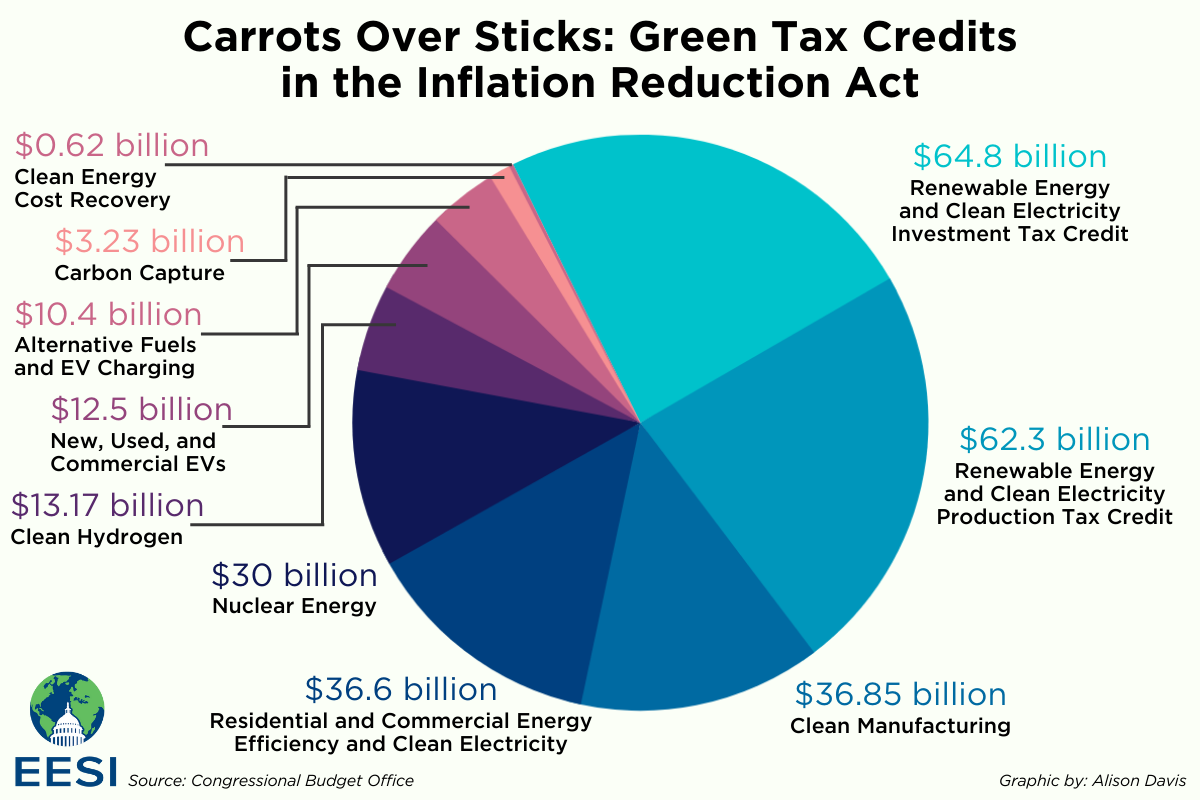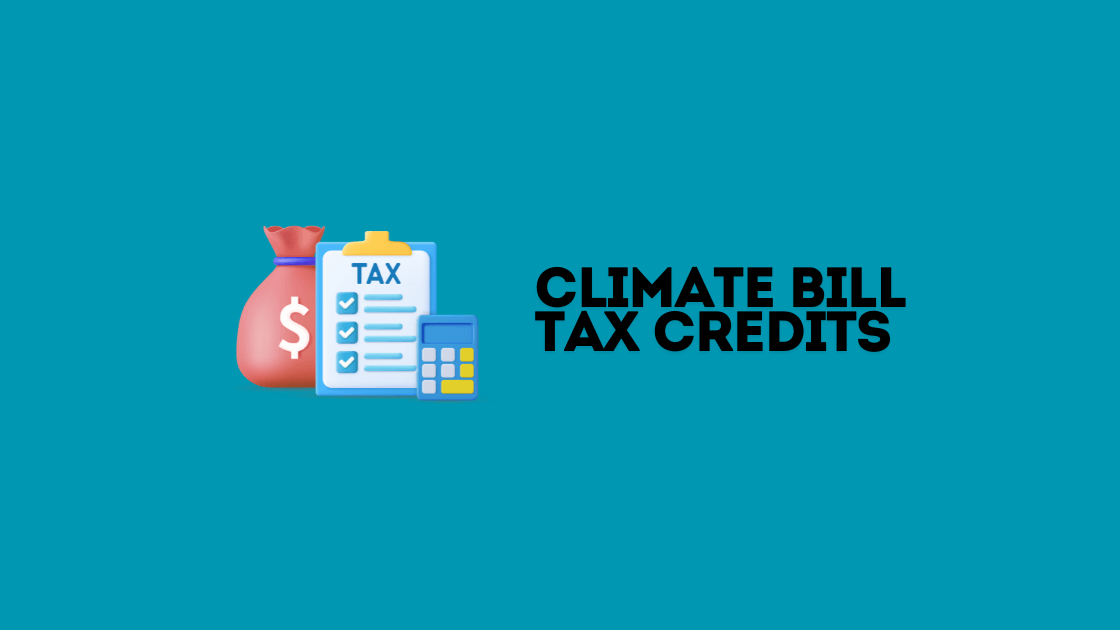Climate Bill Tax Credits: Unlock Big Savings Now!
Climate Bill Tax Credits incentivize investments in renewable energy and sustainable practices. They aim to reduce greenhouse gas emissions and promote clean energy.
Climate Bill Tax Credits play a crucial role in the fight against climate change. These credits offer financial incentives for individuals and businesses to invest in renewable energy sources like solar, wind, and geothermal. By making sustainable choices more affordable, they help reduce dependency on fossil fuels and lower greenhouse gas emissions.
These tax credits are part of broader legislative efforts to promote environmental sustainability and transition towards a greener economy. They encourage innovation and adoption of clean technologies, paving the way for a more sustainable future. Understanding these credits can help you make informed decisions that benefit both the environment and your finances.
The Climate Bill In A Nutshell
The Climate Bill aims to tackle climate change and promote green energy. It introduces tax credits to incentivize eco-friendly practices and reduce carbon emissions. The bill is a significant step toward a sustainable future, impacting various sectors including renewable energy, electric vehicles, and energy efficiency.
Key Provisions And Goals
The Climate Bill outlines several key provisions and goals:
- Tax Credits for Renewable Energy: Incentives for solar, wind, and geothermal energy projects.
- Electric Vehicle (EV) Incentives: Tax credits for purchasing electric cars.
- Energy Efficiency Upgrades: Financial support for improving building insulation and energy systems.
- Carbon Capture: Investments in technology to capture and store carbon emissions.
- Green Job Creation: Funding for training programs in renewable energy sectors.
Impact On Environmental Policy
The Climate Bill significantly impacts environmental policy:
- Reduced Carbon Emissions: Lower greenhouse gases through renewable energy adoption.
- Improved Air Quality: Fewer pollutants from fossil fuels.
- Increased Energy Independence: Reduced reliance on non-renewable energy sources.
- Economic Growth: Job creation in green sectors.
- Technological Innovation: Advances in clean energy technology.
Here’s a quick comparison of the Climate Bill’s impact:
| Aspect | Before Climate Bill | After Climate Bill |
|---|---|---|
| Carbon Emissions | High | Reduced |
| Air Quality | Poor | Improved |
| Energy Source | Non-renewable | Renewable |
| Job Market | Limited Green Jobs | Expanded Green Jobs |

Credit: www.fastcompany.com
Tax Credits 101
Understanding tax credits is crucial for making smart financial decisions. Tax credits can help reduce your overall tax bill, putting more money in your pocket. The new Climate Bill introduces exciting changes that can benefit you and the environment.
Basics Of Tax Credits
Tax credits directly reduce the amount of tax you owe. They differ from tax deductions, which lower your taxable income. There are two main types of tax credits:
- Non-refundable tax credits: Reduce the tax you owe to zero but not beyond.
- Refundable tax credits: Can reduce your tax below zero, resulting in a refund.
Here’s a simple table showing the difference:
| Type | Description |
|---|---|
| Non-refundable | Reduces tax liability to zero, no refund. |
| Refundable | Can result in a refund if tax liability is zero. |
How The Climate Bill Changes The Game
The new Climate Bill introduces fresh tax credits to promote green energy. These credits aim to encourage the use of renewable energy sources and energy-efficient systems.
Key changes include:
- Solar Panel Installation: Receive a credit for installing solar panels on your home.
- Electric Vehicles: Get credits for buying electric or hybrid cars.
- Energy-Efficient Appliances: Earn credits for using appliances that consume less energy.
These new credits not only help the environment but also save you money. Stay informed to make the most of these opportunities.
Big Savings For Homeowners
The new Climate Bill offers big savings for homeowners through enticing tax credits. These credits encourage households to adopt energy-efficient solutions. By upgrading your home, you save money and help the planet.
Energy-efficient Appliances
Investing in energy-efficient appliances can lead to significant savings. These appliances use less energy and reduce utility bills. Here are some examples:
- Refrigerators: Modern models consume less power.
- Washing Machines: Newer versions use less water and energy.
- Dishwashers: Efficient designs save on electricity.
- Air Conditioners: Advanced units cool better with less energy.
Energy-efficient appliances not only cut costs but also qualify for tax credits. These credits can cover a portion of the purchase price.
Home Improvement Incentives
Homeowners can also benefit from home improvement incentives. These incentives support eco-friendly renovations. Here are some key areas:
- Insulation: Proper insulation reduces heating and cooling costs.
- Solar Panels: Solar energy cuts electricity bills significantly.
- Windows: Energy-efficient windows improve home temperature control.
- Heating Systems: Modern systems are more efficient and reliable.
These improvements not only enhance home comfort but also qualify for substantial tax credits. Here is a brief table summarizing the potential savings:
| Improvement Type | Potential Savings |
|---|---|
| Insulation | Up to $500 |
| Solar Panels | 30% of the cost |
| Energy-Efficient Windows | Up to $200 |
| Modern Heating Systems | Up to $300 |
By leveraging these tax credits, homeowners can make impactful changes. These changes not only save money but also contribute to a greener future.

Credit: www.eesi.org
Electric Vehicles: Driving Green, Saving Big
Electric vehicles (EVs) are the future of transportation. They help the environment and save you money. Thanks to the climate bill, there are new tax credits available.
Ev Purchase Credits
The climate bill offers EV purchase credits. These credits reduce the cost of buying an electric vehicle. You can save thousands of dollars.
- Up to $7,500 for new electric vehicles
- Up to $4,000 for used electric vehicles
These credits make EVs more affordable. More people can switch to electric cars. This reduces pollution and helps the planet.
Charging Infrastructure Rebates
Charging stations are key for electric vehicles. The climate bill offers charging infrastructure rebates. These rebates help with the cost of installing charging stations.
- Rebates cover up to 30% of installation costs
- Maximum rebate amount is $1,000
Installing a charging station at home becomes cheaper. More charging stations will be built. This makes it easier to own an electric vehicle.
| Tax Credit Type | Details |
|---|---|
| EV Purchase Credits | Up to $7,500 for new EVs, $4,000 for used EVs |
| Charging Infrastructure Rebates | Up to 30% of costs, max $1,000 |
Renewable Energy Systems
Climate Bill Tax Credits make renewable energy systems affordable. These systems help reduce carbon footprints. They also save money on energy bills. Two popular renewable energy systems include solar panel installations and wind turbine investments.
Solar Panel Installations
Solar panels convert sunlight into electricity. This reduces the need for fossil fuels. Tax credits make solar panel installations more affordable.
- Reduce electricity bills: Solar panels produce free electricity.
- Eco-friendly: Solar energy is clean and renewable.
- Increase property value: Homes with solar panels sell faster.
Installing solar panels is simple. Here are the steps:
- Consult a solar energy expert.
- Choose the right solar panel system.
- Schedule the installation date.
- Get your system connected and start saving.
Wind Turbine Investments
Wind turbines convert wind energy into electricity. They are ideal for areas with strong winds. Tax credits lower the cost of wind turbine investments.
- Lower energy costs: Wind turbines produce free electricity.
- Environmentally friendly: Wind energy is clean and renewable.
- Support grid stability: Wind turbines can supply excess energy.
Investing in wind turbines involves several steps:
- Assess your property’s wind potential.
- Consult a wind energy expert.
- Select the right wind turbine.
- Schedule the installation.
- Start generating clean energy.
Both solar panels and wind turbines offer significant benefits. Tax credits make these renewable energy systems more accessible. By investing in them, you help the environment and save money.

Credit: www.fastcompany.com
Corporate Benefits
The Climate Bill offers significant corporate benefits through various tax credits. These advantages encourage companies to adopt sustainable practices and contribute to a greener future. Explore the key benefits below.
Incentives For Sustainable Business Practices
Businesses adopting green practices can gain multiple incentives. These include:
- Grants for renewable energy projects
- Subsidies for energy-efficient upgrades
- Discounted loans for sustainability initiatives
These incentives make it easier and cheaper for companies to go green. A focus on sustainability can also enhance a company’s public image. This can attract more customers and investors.
Tax Advantages For Green Companies
Companies that embrace green technologies can benefit from various tax advantages:
| Tax Credit | Description |
|---|---|
| Renewable Energy Tax Credit | Credits for investing in solar, wind, or geothermal energy |
| Energy Efficiency Tax Credit | Credits for improving energy efficiency in buildings |
| Electric Vehicle Tax Credit | Credits for purchasing electric or hybrid vehicles |
These tax credits can significantly reduce a company’s tax liability. Companies can reinvest these savings into further green initiatives. This creates a cycle of sustainability and financial benefits.
Navigating The Application Process
The Climate Bill Tax Credits offer significant savings for eco-friendly initiatives. Navigating the application process can be simple with the right guidance. This section will help you understand how to claim your credits.
Eligibility Criteria
Before you start, ensure you meet the eligibility criteria:
- You must be a U.S. taxpayer.
- Your project must focus on renewable energy or energy efficiency.
- You must provide documentation proving your project’s compliance.
Step-by-step Guide To Claiming Credits
Follow these steps to claim your Climate Bill Tax Credits:
- Gather Required Documents: Collect all necessary documentation, including receipts and compliance certificates.
- Complete IRS Form 5695: This form is essential for residential energy credits.
- Fill Out Your Tax Return: Include the credits on your federal tax return.
- Submit Your Application: Double-check everything before submission to avoid errors.
Here is a table summarizing the key steps:
| Step | Action | Details |
|---|---|---|
| 1 | Gather Documents | Receipts, certificates, and other proof of compliance |
| 2 | Complete Form 5695 | Required for residential energy credits |
| 3 | Fill Out Tax Return | Include the credits on your federal tax return |
| 4 | Submit Application | Double-check and submit your application |
By following these steps, you can successfully claim your Climate Bill Tax Credits. Ensure all information is accurate to avoid delays.
Long-term Financial Planning
Long-term financial planning is crucial for securing a stable future. The Climate Bill Tax Credits offer a unique opportunity to enhance your financial strategy. Proper planning can maximize savings and prepare you for policy changes. Learn how to strategically invest and anticipate future shifts.
Maximizing Savings Through Strategic Investments
Strategic investments can significantly boost your savings. With Climate Bill Tax Credits, you can invest in renewable energy. Installing solar panels, for example, can reduce energy costs.
- Solar panels: Lower monthly electricity bills
- Wind turbines: Generate your own energy
- Electric vehicles: Save on fuel costs
Consider energy-efficient appliances. These can further reduce utility bills. Over time, these savings add up. Invest wisely to make the most of these tax credits.
Anticipating Future Policy Changes
Policy changes can impact your financial planning. Stay informed about new regulations. This helps you adapt quickly. Knowing future trends allows you to plan better.
| Current Policy | Potential Changes |
|---|---|
| Tax credits for solar panels | Increased credits for larger systems |
| Incentives for electric vehicles | Higher rebates for zero-emission cars |
Consider diversifying your investments. This can protect you from sudden changes. Having a flexible plan ensures you’re always prepared.
Keep an eye on government updates. They can offer new opportunities. Staying proactive helps you make the most of your resources.
Case Studies: Success Stories
The Climate Bill Tax Credits have enabled many to make eco-friendly choices. This section highlights some inspiring success stories. These examples show how tax credits have transformed homes and businesses.
Residential Triumphs
John and Mary from Colorado used tax credits to install solar panels. Their energy bills dropped by 50%. They also received rebates for their energy-efficient home improvements.
- Solar panels installation
- Energy-efficient windows
- Smart thermostats
The Smith family from California invested in an electric vehicle (EV). The tax credits covered 30% of the EV cost. They now enjoy savings on fuel and maintenance.
| Family | State | Eco-Friendly Changes | Savings |
|---|---|---|---|
| John and Mary | Colorado | Solar Panels | 50% on bills |
| Smiths | California | Electric Vehicle | 30% on EV |
Corporate Wins
Tech Corp in Texas used Climate Bill Tax Credits to upgrade their office. They installed energy-efficient lighting and HVAC systems. These changes reduced their energy use by 40%.
- Energy-efficient lighting
- HVAC systems upgrade
GreenBiz in New York invested in renewable energy sources. They set up a wind turbine on their property. The tax credits helped them save 35% on the project cost.
| Company | State | Eco-Friendly Changes | Savings |
|---|---|---|---|
| Tech Corp | Texas | Lighting and HVAC | 40% on energy use |
| GreenBiz | New York | Wind Turbine | 35% on project |
The Bigger Picture
Understanding the bigger picture of Climate Bill Tax Credits helps us see their long-term benefits. These credits not only provide immediate financial relief but also pave the way for a sustainable future. Let’s explore how they impact the economy and contribute to global climate goals.
Economic Impact Of Tax Credits
Climate Bill Tax Credits drive economic growth. They encourage businesses to invest in green technologies.
| Sector | Impact |
|---|---|
| Renewable Energy | Increased investments and job creation |
| Manufacturing | Reduced production costs and innovation |
| Transportation | Development of electric vehicles and infrastructure |
Consumers also benefit. They get rebates for using energy-efficient appliances.
- Lower utility bills
- Improved home values
- Better air quality
Contribution To Global Climate Goals
Tax credits make a significant contribution to global climate goals. They help reduce carbon emissions.
- Incentivize renewable energy adoption
- Promote sustainable practices
- Support international climate agreements
By adopting these measures, countries can meet their climate targets. This collective effort ensures a healthier planet.
Every individual action counts. Small changes lead to big results in the fight against climate change.
Can Freezing My Credit Affect My Eligibility for Climate Bill Tax Credits?
Freezing your credit will not impact your eligibility for climate bill tax credits. However, if you freeze your credit with equifax, it may temporarily delay identity verification for certain financial transactions. Ensure all necessary tax documents are accessible before initiating a credit freeze to avoid potential complications with your application process.
Frequently Asked Questions
How Do You Qualify For The Inflation Reduction Act Rebate?
To qualify for the Inflation Reduction Act rebate, meet income eligibility criteria and purchase qualifying energy-efficient products. Ensure documentation and receipts are available for verification. Check specific program guidelines for details.
What Appliances Qualify For Energy Tax Credit 2024?
Energy tax credit 2024 applies to solar panels, solar water heaters, energy-efficient windows, doors, insulation, and HVAC systems. Ensure appliances meet Energy Star requirements. Check IRS guidelines for detailed eligibility.
How Do I Get Money From The Inflation Reduction Act?
Apply for available grants, tax credits, or rebates. Visit the official government website for eligibility and application details.
What Kind Of Heat Pumps Qualify For Federal Tax Credits?
Energy-efficient heat pumps meeting federal criteria qualify for tax credits. Eligible types include air-source, geothermal, and dual-source models. Always check current federal guidelines for specifics.
What Is A Climate Bill Tax Credit?
A climate bill tax credit offers financial incentives for eco-friendly practices and investments, reducing your tax liability. In addition to reducing your tax liability, these tax credits can also help offset the initial costs of implementing green practices or making sustainable investments. However, understanding the eligibility requirements and navigating the application process can be complex. To ensure that you are maximizing your benefits and taking advantage of all available credits, it may be wise to seek professional guidance and explore legal strategies for credit repair. By consulting with experts in tax law and green investments, you can ensure that you are making the most of these financial incentives while also contributing to a healthier planet.
Conclusion
Climate Bill tax credits offer significant benefits for both individuals and businesses. They promote sustainable energy investments and reduce carbon footprints. By taking advantage of these credits, you can save money and help the environment. Stay informed and make the most of these opportunities to contribute to a greener future.







